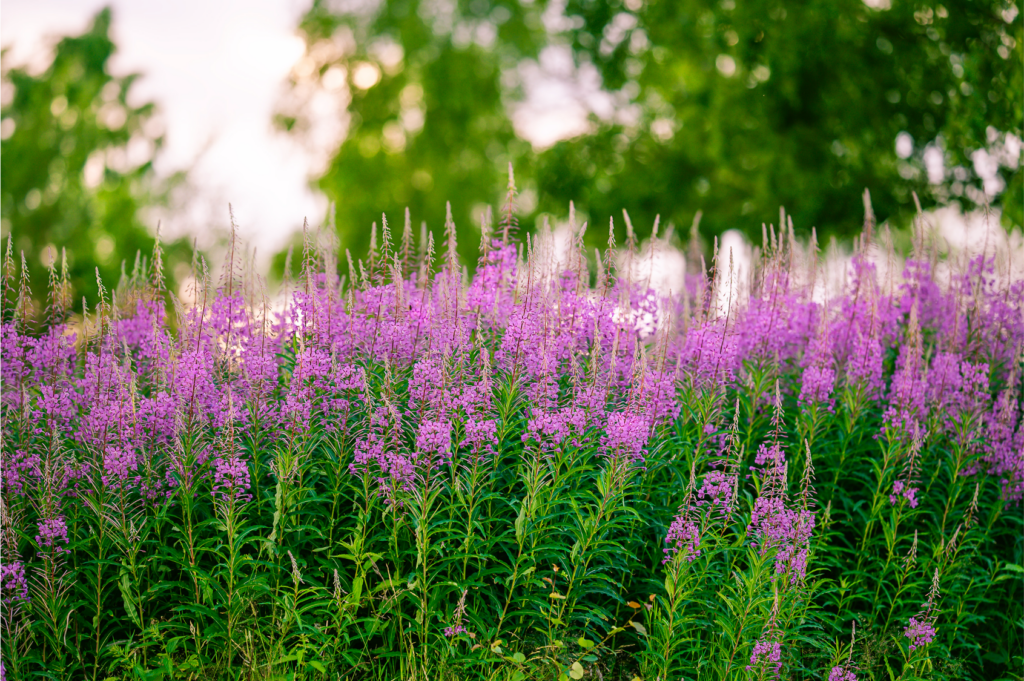By Kathy Abascal
I am told that you can measure when summer will end by watching fireweed (Epilobium angustifolium) bloom. Here on Vashon, its purple flowers began to open at the base of its stem in early July. They then work their way up until finally the tips of the plant are in bloom. When that happens, summer is just about over. Fireweed is reasonably common on the Island, so you can watch summer progress by keeping an eye on this plant.
There are about 200 species of fireweed, and they prefer to grow either at relatively high latitudes or high altitudes. This plant is found in all parts of the world, but the further north you go, the bigger and more abundant it gets. I used to gather it in the Colorado Rockies where it was at most a knee-high plant. It was a joy to come to Vashon and find plants towering over the blackberries along the Island side roads.
As you go further north, to places like Sweden or Alaska, you can find meadows of large fireweed plants. Fireweed is a perennial, and its flowers range from lavender to pink to carmine-purple; its pods are long, narrow, and filled with feathery seeds.
Fireweed has been widely used as a medicine and a food in many parts of the world. Young shoots were eaten and used as fodder for animals. I am told that the shoots taste a bit like asparagus, but I keep forgetting to gather some in spring to try. The seed fluff was used as a fire-starter, and some say its common name comes from the ease with which the fluff catches fire. Cloth has been found woven soley from the seed plumes, which were also used to make thread. The Swedes call the plant mjoelke or “milky” based on their observations that cows grazing on fireweed produce more milk. Fireweed leaves also make a nice galactagogue tea for human mothers.
Medicinally, the Native Americans used fireweed for burning urination, male urination problems, coughs and sore throats, stomach aches and intestinal discomfort, bowel hemorrhage, gastritis, tuberculosis, and as a panacea for pain. They also used it as a poultice for boils, abscesses, bruises, infected sores, cuts, wounds, and other skin ailments. Various Eskimo and Siberian tribes used the plant similarly. Fireweed species were used in both Egyptian and European folk medicine to treat inflammation, adenoma, and prostate tumors. The Europeans also used the plant to treat skin disorders such as eczema, dandruff, as well as for menstrual disorders.
The Eclectic physicians considered fireweed unequalled as a treatment for diarrhea, including when caused by cholera and dysentery. According to the Eclectics, fireweed can be tinctured, but works best as a tea infusion. They preferred frequent small doses of the tea for diarrhea, recommending a dose as often as every 10 minutes.
Although there is little clinical research on the plant, studies show that most fireweed species have analgesic, anti-inflammatory, antimicrobial, anti-tumor, and prostate-related activities. Thus, infusions of fireweed strongly reduced prostaglandin release in animals, and worked as well as indomethacin at preventing edema. Like indomethacin, fireweed inhibited platelet aggregation but, unlike the drug, did not cause stomach ulcers. The researchers speculated that fireweed is safer than non-steroidal anti-inflammatory drugs, and works by inhibiting the production of leukotrienes that sustain inflammatory reactions in the body.
Tinctures of fireweed are antimicrobial and inhibit many types of bacteria, yeast, and fungi. In various studies, fireweed very strongly inhibited Microsporum canis (a cause of fungal skin problems), strongly inhibited Staphylococcus aureus and Escherichia coli, and weakly inhibited Candida albicans. These test tube studies suggest that folk uses of fireweed for skin problems and diarrhea may eventually be validated as effective – if these uses are ever studied, of course.
Finally, fireweed has some potentially very interesting benefits for the prostate. Tinctures of various fireweed species inhibit aromatase, an enzyme that converts testosterone into estrogen. In one study, two of fireweed’s constituents had a considerably greater inhibitory action on 5 alpha-reductase than the prostate drug finasteride. This, of course, strongly supports European and Egyptian folk uses of the fireweed plant for prostate issues, and Native American uses for “male urinary problems.” Again, there are no clinical studies on fireweed for this use, which is a shame.
Fireweed has no known toxic effects, a fact borne out by its worldwide use as food for both humans and animals. It is a lovely plant that makes a quite pleasant tea. If it is growing along your roads, I suggest harvesting and drying leaves for tea. If it is not, you might want to gather some seed fluff this fall and plant the seed in some sunny spot to remind you to enjoy summer while it lasts.

